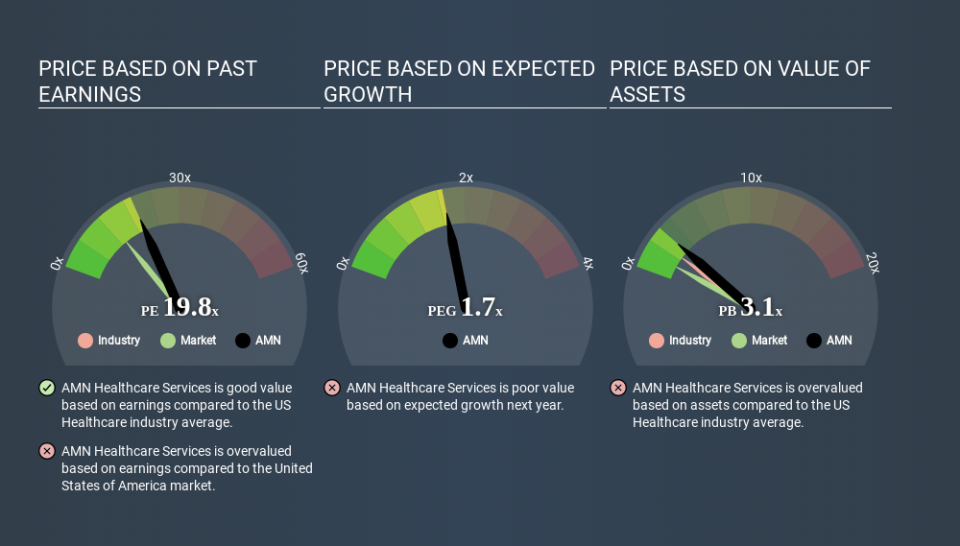How Does AMN Healthcare Services's (NYSE:AMN) P/E Compare To Its Industry, After The Share Price Drop?

To the annoyance of some shareholders, AMN Healthcare Services (NYSE:AMN) shares are down a considerable 35% in the last month. Looking back further, the stock is up 2.5% in the last year.
Assuming nothing else has changed, a lower share price makes a stock more attractive to potential buyers. In the long term, share prices tend to follow earnings per share, but in the short term prices bounce around in response to short term factors (which are not always obvious). So, on certain occasions, long term focussed investors try to take advantage of pessimistic expectations to buy shares at a better price. One way to gauge market expectations of a stock is to look at its Price to Earnings Ratio (PE Ratio). Investors have optimistic expectations of companies with higher P/E ratios, compared to companies with lower P/E ratios.
Check out our latest analysis for AMN Healthcare Services
Does AMN Healthcare Services Have A Relatively High Or Low P/E For Its Industry?
AMN Healthcare Services's P/E is 19.78. You can see in the image below that the average P/E (19.4) for companies in the healthcare industry is roughly the same as AMN Healthcare Services's P/E.
Its P/E ratio suggests that AMN Healthcare Services shareholders think that in the future it will perform about the same as other companies in its industry classification. So if AMN Healthcare Services actually outperforms its peers going forward, that should be a positive for the share price. I would further inform my view by checking insider buying and selling., among other things.
How Growth Rates Impact P/E Ratios
Earnings growth rates have a big influence on P/E ratios. If earnings are growing quickly, then the 'E' in the equation will increase faster than it would otherwise. That means even if the current P/E is high, it will reduce over time if the share price stays flat. A lower P/E should indicate the stock is cheap relative to others -- and that may attract buyers.
AMN Healthcare Services's earnings per share fell by 18% in the last twelve months. But over the longer term (5 years) earnings per share have increased by 28%.
Don't Forget: The P/E Does Not Account For Debt or Bank Deposits
It's important to note that the P/E ratio considers the market capitalization, not the enterprise value. So it won't reflect the advantage of cash, or disadvantage of debt. Hypothetically, a company could reduce its future P/E ratio by spending its cash (or taking on debt) to achieve higher earnings.
Such spending might be good or bad, overall, but the key point here is that you need to look at debt to understand the P/E ratio in context.
How Does AMN Healthcare Services's Debt Impact Its P/E Ratio?
AMN Healthcare Services's net debt is 24% of its market cap. This could bring some additional risk, and reduce the number of investment options for management; worth remembering if you compare its P/E to businesses without debt.
The Bottom Line On AMN Healthcare Services's P/E Ratio
AMN Healthcare Services trades on a P/E ratio of 19.8, which is above its market average of 13.0. With some debt but no EPS growth last year, the market has high expectations of future profits. What can be absolutely certain is that the market has become significantly less optimistic about AMN Healthcare Services over the last month, with the P/E ratio falling from 30.3 back then to 19.8 today. For those who prefer to invest with the flow of momentum, that might be a bad sign, but for a contrarian, it may signal opportunity.
When the market is wrong about a stock, it gives savvy investors an opportunity. As value investor Benjamin Graham famously said, 'In the short run, the market is a voting machine but in the long run, it is a weighing machine. So this free visualization of the analyst consensus on future earnings could help you make the right decision about whether to buy, sell, or hold.
Of course, you might find a fantastic investment by looking at a few good candidates. So take a peek at this free list of companies with modest (or no) debt, trading on a P/E below 20.
If you spot an error that warrants correction, please contact the editor at editorial-team@simplywallst.com. This article by Simply Wall St is general in nature. It does not constitute a recommendation to buy or sell any stock, and does not take account of your objectives, or your financial situation. Simply Wall St has no position in the stocks mentioned.
We aim to bring you long-term focused research analysis driven by fundamental data. Note that our analysis may not factor in the latest price-sensitive company announcements or qualitative material. Thank you for reading.

